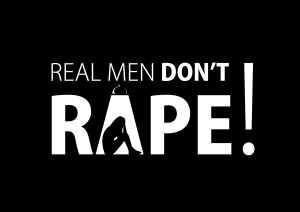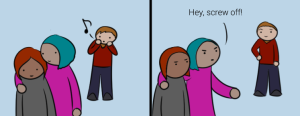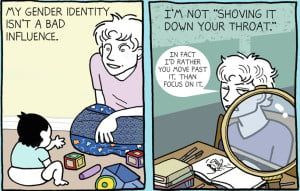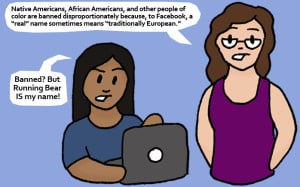
A young teacher sitting with three students, reading through a textbook.
Someone once told me that as a person of privilege in justice work, the moment I decide that I’m not part of the problem, I am the problem.
I wish they had told me that before I started teaching on the West side of Chicago. I went into teaching with some basic understandings of race and racism, and I assumed that was enough to make me an anti-racist teacher.
I was great at speaking about racial justice ideas (probably in some super condescending ways). Translating those anti-racist commitments into accountable pedagogy that might make my classroom and school a more racially just place was a different story.
In my years in the field of education, I’ve found four general reactions from White educators to the notion that we must do more to transform ourselves and our teaching methods to make them more anti-racist.
Resistance: Some White teachers blow off suggestions that they might be contributing to racism in schools as “liberal nonsense” or feign race-neutrality, claiming that they only see children, not color.
Guilt: Others fall into a place of White guilt, never taking any sort of action because they feel mired in feelings of personal responsibility for all racial wrong rather than accountable attention to one’s complicity in racism in schools.
Drawing on Janet Helms, Beverly Daniel Tatum notes that most White folks find themselves in a place of guilt at one time or another. What defines our character is how we push through guilt and toward accountable action for racial justice in community.
All Talk, No Action: Research finds that increasingly, White teachers can articulate that they need to “check their privilege” without ever actually translating statement that into any form of transformative pedagogy or anti-racist identity that is accountable to students of Color, colleagues of Color, and/or families of Color.
I’ve come to realize that this gap between knowledge and action is one of the greater challenges in realizing racial justice pedagogies among the 80% of our teachers who are White.
Accountable Action Toward Racial Justice: Despite the tendency so many of us have to fall into one of the above categories, more and more White teachers are finding ways to transform their teaching practices to center their students (particularly those with marginalized identities) and work to repay “the education debt.”
As a teacher, I was “All Talk, No Action.” I could quote Lisa Delpit and bell hooks to you while I built a classroom that reinforced Whiteness as normative and did little to center my students’ identities and needs or truly challenge racist education norms.
Of course, it’s never quite as simple as fitting into these over-simplified categories. Many of us move fluidly between them. But the point is that we need more White teachers who are willing to take up the difficult work of racial justice education praxis.
As White educators, we must move beyond simple acknowledgments of privilege and work to transform the conditions that create said privilege.
It is with this in mind, and with tremendous love for those who commit themselves to the daily work of educating young people, that I offer 5 things that White teachers personally can do to help them realize more racially-just classrooms.
In no way are these suggestions comprehensive, but they’re meant to help push more White teachers to live anti-racist pedagogies.
1. Investigate What it Means to be White
So often, we are encouraged as educators to investigate the racialized realities of our students of Color, but never is Whiteness interrogated.
As White educators, we don’t often question how the racial identity of White students forms their educational experience. And we almost never ask what it means to be White in the context of our teaching.
But if race in education is only framed through a focus on people of Color, we invisibilize Whiteness, our own racial identities as White teachers, and how the power central to Whiteness plays out in our teaching.
In Race, Whiteness, and Education, Zeus Leonardo is careful to point out that Whiteness is a discourse of power, but White people are not Whiteness. We have a relationship to Whiteness and, by extension, systems of power. Thus, we face a choice.
White teachers have a responsibility to transform their relationship to Whiteness to live our lives and enact our pedagogies in ways that are anti-racist – as the alternative is to live in ways that support the racial oppression inherent in Whiteness.
Things to Ask Yourself: What does it mean to be White? As a White person, what is my relationship to power in our society, in our school, and in my classroom (and how is this relationship different than for people of Color)? How might I imagine different ways of being White that are more aligned with racial justice (both in my classroom and more generally)?
Resources for Further Investigation: The History of White People by Nell Irvin Painter; The Wages of Whiteness by David Roediger; Talking About Race, Learning About Racism by Beverly Daniel Tatum; What Does It Mean to Be White? by Robin DiAngelo
2. Understand and Work to Undermine the Essential Racialization of Education and Teaching
The public education systems in the United States (and most private systems for that matter) were designed, more than any other singular goal, to consolidate wealth, power, and access for the benefit of White men.
For as long as there have been schools in the US, there have been three tiers of education:
1. A private system that serves a majority-White elite
2. A public system with moderate to robust funding that serves middle to high income people (and by extension, mostly White people)
3. An under-resourced system fought for by the most marginalized in society that serves (or too often doesn’t serve) students of Color and the poorest of White folks.
Schools have always been racially segregated, and they are as segregated now as they were in the Civil Rights era. But we should be clear: Segregation isn’t an issue because proximity to White people is some kind of magical fairy dust that makes kids of Color perform better on tests.
Segregation is about distribution of resources: White schools are, by and large, far better resourced than schools that serve people of Color.
And while many White educators point to Brown v. Board as the pivotal ruling that allows for “equality” in education (as if all things got better after that point), Derrick Bell reminds us that this seminal ruling allowed White America to claim progress while doing little to change the material conditions of students of Color.
What Brown v. Board accomplished more than anything was to take under-resourced schools run by people of Color that serve students of Color and “professionalize” them by putting White people in charge.
Little changed materially for the vast majority of students in terms of our segregated system – we just put White people in charge and pushed people of Color out of teaching.
After all, as W.E.B. Du Bois pointed out eighty years ago, “A mixed school with poor and unsympathetic teachers, with hostile public opinion, and no teaching of truth concerning black folk, is bad. A segregated school with ignorant placeholders, inadequate equipment, poor salaries, and wretched housing, is equally bad.”
The point is that the “education debt” that we see today reminds us that our schools were not built to be places of radical pedagogy and racial justice. But that doesn’t meant that they cannot be transformed to serve the function of racial justice.
However, if we don’t commit ourselves to new and radical ways of functioning as White educators, we simply continue the legacy of White-serving education systems that maintain the dominant racial order.
Things to Ask Yourself: In what ways does the unspoken Whiteness of education show up in how I teach? In what ways might I challenge the racist history of education in my classroom and in our school?
Resources for Further Investigation: All of the articles linked above; The Invisible Quality of Whiteness in Our Schools by Gilda Ochoa; The Unexamined Whiteness of Teaching by Bree Picower
3. Investigate How to Decenter Whiteness in Curriculum and Center Experiences and Narratives of People of Color
One of the myriad reasons that White students succeed in White systems of education is because our knowledge and ways of thinking, teaching, learning, and demonstrating as White people are recognized as “official knowledge.”
That is, our histories and ways of thinking and knowing are reflected, valued, and legitimized in every aspect of education, but that’s far from true for people of Color.
But there are all sorts of models for us to consider in how to decenter Whiteness and center the narratives and experiences and knowledge of people of Color.
Ethnic Studies has long been known by people of Color to be a powerful form of resistance to Whiteness in education (which is why some racists banned it in Arizona) that even helps students of Color succeed by White measures of success.
Notably, though, I don’t think every White teacher should just take up Ethnic Studies. It shouldn’t be the newest curricular fad in education.
After all, we did that with Multicultural Education in the 80s and 90s and reduced a multi-faceted, complex alternative to White systems to food sharing and parades of ethnic dress.
However, I do think there is much to be learned from the Ethnic Studies movement.
Additionally, students and families of Color are the greatest experts on their own learning, so the more we can take ourselves out of the center (and control) of our classrooms and schools and support students in teaching one another, the more we center students in their learning (no matter their race). Christopher Emdin offers some fantastic models for this in his new book.
Things to Ask Yourself: In what ways can I help my students acquire the skills and knowledge they need in ways that puts them (rather than me) at the center of their learning? How am I teaching and assessing my students in ways that value White ways of thinking while devaluing their own knowledge and skills?
Resources for Further Investigation: For White Folks Who Teach in the Hood by Chris Emdin; Teaching Strategies for Ethnic Studies by James Banks; The Reading to End Racism Library
4. Understand Microaggressions and How They Might Show Up in Your Teaching
Simply put, microaggressions show up in every teacher’s classroom because everyone commits them from time to time! Not sure what microaggressions are? Check it:
https://www.youtube.com/watch?v=BJL2P0JsAS4
From calling students by the wrong name (because all people of Color look the same, right?) or refusing to learn names that are difficult for us to pronounce to tokenizing students of Color by asking them to speak as a representative of their race, microaggressions show up in teaching all the time!
Knowing that we are all going to commit microaggressions against students, colleagues, and parents of Color from time to time, it’s important to be vigilant.
And when we commit them, apologize and work to be accountable moving forward.
Things to Ask Yourself: Do I have a solid understanding of my own biases and how they may show up in my teaching? What would it look like to be publicly accountable and apologize when I’ve acted in a microaggressive way in my classroom? How might I talk to students or colleagues privately to listen to how they might like me to respond when I’ve committed or witnessed a microaggression in my school?
Resources for Further Investigation: Microaggressions in Everyday Life by Derald Wing Sue; 4 Ways Teachers Can Address Microaggressions in the Classroom by Kimberly Griffin; Microaggressions and Everyday Racism by Daniel Solorzano
5. Invest in Responsible, Accountable Conversations with White Colleagues about Race, Racism, and Your School
Far too often, the work of racial justice in schools is left solely to people of Color, with White teachers pretending like it’s not “our fight.”
But we need to remember: Racist systems in the US were invented by White people, so we must take responsibility for dismantling those systems.
This is not to say that we should go in and take over when folks of Color have been doing important work to address racism in schools for years, but we do need to tap in, listen, and figure out how we can aid in the work of transforming our schools.
One of the most important responsibilities that White educators have is to work with fellow White people to interrupt racism (minimally) and call more White folks to act for racial justice.
Thus, we have a responsibility to do more than simply close our door and serve our students in the best way possible. When we hear one of our colleagues call a students family “illegals” or when we hear students describe the racist way a colleague treats students or when our White colleagues engender and support discipline policies that advance the school-to-prison pipeline, we need to call them in.
Isolation serves White supremacy, which is why the myth of meritocracy and self-reliance is so central to the project of Whiteness.
Thus, we have a responsibility to work both in diverse community and in all-White spaces to dismantle how racism functions in our schools.
Things to Ask Yourself: What racially problematic patterns do I see showing up among my colleagues? What tone and language is best to open dialogue about how all White teachers can do better to make our schools more racially just? Am I subtly or overtly acting like the “best anti-racist White person” in how I choose to call out/in my colleagues? How can I rely on White teachers for support in anti-racist work so that I don’t demand emotional energy solely from people of Color?
Resources for Further Investigation: AWARE-LA (a group of White educators who work for racial justice); Showing Up for Racial Justice (a network of White people working to end racism); White Teachers, Diverse Schools by Julie Landsman and Chance Lewis
***
Clearly articulate your racial justice values. Then hold yourself to living those values.
For any of the above to be possible, though, we need to be able to clearly articulate our racial justice values. In order to realize true accountable action for racial justice in community, White people need to have a two-pronged commitment that informs us:
First, we need to have a deep and empathic concern for and accountability to people of Color.
Through this concern, we must believe people of Color when they speak the truths about their lived realities of racism, and we must trust the leadership of people of Color (especially since Whiteness socializes us to value the leadership of White people above all others).
Part of this means reflecting deeply on which people of Color-led vision for racial justice we most align with. After all, people of Color are not a monolith, and while we can be respectful and strive to not be racist to all folks of Color, we can’t be accountable to everyone.
Some visions for justice are in direct conflict with one another, while others only differ in nuance. We must listen widely and decide where we stand.
But if we can’t articulate with whom we align in wanting to realize justice in our schools and our society, how can we be accountable?
Second, we must understand what we personally have at stake in ending racism.
Our empathic concern for people of Color must be at the center of our commitment, but if our only commitment to ending racism stems from empathy, we can quickly and easily slide into racist paternalism.
As Lilla Watson said, “If you have come here to help me, you are wasting your time. But if you have come because your liberation is bound up with mine, then let us work together.” To see our liberation as bound up with that of people of Color takes some deep reflection, on the other side of which, hopefully we can articulate our stake in ending racism.
White supremacy hurts White people too, though in ways that are not at all comparable to people of Color. We must be able to see how we are hurt by racist systems in order to understand what skin we have in the game.
As educators, whether we like to admit it or not, racism is likely showing up in our teaching practice at some level. And mitigating the ways racism shows up in our practice is about more than finding the right tools for inclusive classrooms.
Addressing racism as White educators means living into our moral responsibility for a different kind of teaching, one where our goal is to do more than maintain the status quo (which is demonstrably racist) and where, frankly, “but if just we reach one student” isn’t enough.
We are in a time when more and more White people are waking up to our responsibility to address racism and our complicity in it.
Our question then becomes: How do you define your responsibility to address racism in education, and how will you live in to that responsibility?
[do_widget id=’text-101′]
Jamie Utt is the Founder and Director of Education at CivilSchools, a comprehensive bullying prevention program, a diversity and inclusion consultant, and sexual violence prevention educator based in Tucson, AZ. He is currently working toward his PhD in Teaching, Learning, and Sociocultural Studies at the University of Arizona with research interests in the role that White teacher’s racial identity plays in their teaching practice. Learn more about his work at his website here and follow him on Twitter @utt_jamie. Read his articles here and book him for speaking engagements.
Search our 3000+ articles!
Read our articles about:
Our online racial justice training
Used by hundreds of universities, non-profits, and businesses.
Click to learn more
Most Read Articles
- « Previous
- 1
- …
- 30
- 31
- 32



















